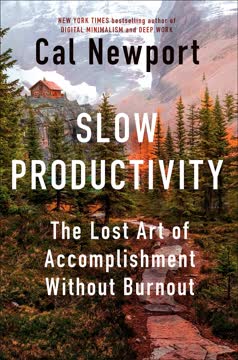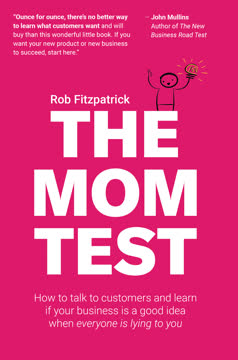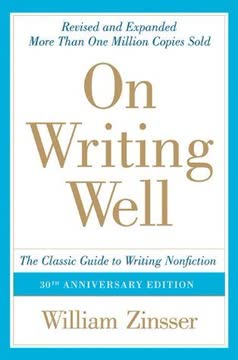Key Takeaways
1. Design your nonfiction book for long-lasting recommendability
Your book's promise should appear in (or at least be strongly implied by) its title and/or subtitle.
Problem-solving focus: Design your nonfiction book as a problem-solver rather than a pleasure-giver. Identify a specific problem or goal that your ideal reader has, and structure your book around providing a clear solution or path to achievement. This approach makes your book more recommendable and valuable to its target audience.
Clear promise: Ensure your book's title and subtitle clearly communicate its promise to the reader. This helps potential readers quickly understand if the book is relevant to their needs and increases the likelihood of them purchasing and recommending it. Consider using a format that directly states the problem your book solves or the outcome it delivers.
- Examples of clear, problem-solving titles:
- "How to Stay Alive in the Woods" by Bradford Angier
- "The Workshop Survival Guide" by Rob Fitzpatrick and Devin Hunt
- "Atomic Habits" by James Clear
2. Test and improve your book before writing through reader conversations
Listening and teaching are part of writing.
Reader conversations: Engage in two types of conversations with potential readers before writing your manuscript:
- Listening/understanding conversations to verify and improve your scope
- Teaching/helping conversations to refine your table of contents and structure
Table of Contents (ToC) optimization: Create a detailed ToC with clear, descriptive language and subsections that outline the book's main takeaways. Use this ToC as a blueprint for your book's educational design and to guide your conversations with potential readers.
- Tips for creating an effective ToC:
- Use clear, descriptive titles for sections and subsections
- Include the primary learning outcome or takeaway in each title
- Add detailed subsections to provide a comprehensive overview of the content
3. Create an engaging reader experience by front-loading value
At least every few pages, you want your reader to be thinking, "Oh wow, I can use that."
Value-per-page: Focus on delivering consistent value throughout your book. Aim to provide useful insights, actionable advice, or thought-provoking ideas on every page to keep readers engaged and motivated to continue reading.
Front-loading strategies:
- Begin with your most impactful content to hook readers immediately
- Rearrange your content to insert pieces of real value earlier in the book
- Consider starting with your book's "big reveal" or main takeaways
Editing for engagement: Use your Table of Contents to visualize the reader experience by adding word counts to section titles. This allows you to identify and address:
- A slow start
- Long slogs without major insights
- Sections with high word count relative to their value
4. Leverage beta readers to refine your manuscript
Beta readers are neither paid professionals nor kindhearted friends. Rather, they are actual, honest-to-god readers who want what you're creating so badly that they're willing to endure an early, awkward, broken manuscript just to get it.
Beta reading process: Start beta reading early, when your manuscript still has problems. This allows you to catch and fix big issues before investing too much time in detailed editing and refinement.
Gathering feedback: Look for three types of insights from beta readers:
- Qualitative insights from their comments
- Quantitative insights based on where they become bored or stop reading
- Observational insights on how they apply the book's ideas in their lives
Iterative improvement: Run beta reading in 2-8 week iterations, with 3-5 deeply engaged readers per round. Use their feedback to continually improve your manuscript until it meets the following criteria:
- It's easy to recruit new beta readers (Desirable)
- Most readers are receiving value and reaching the end (Effective and Engaging)
- Some readers are bringing in their friends (recommendation loop is running)
5. Implement effective seed marketing strategies
Launch is a year, not a day.
Seed audience: Aim to get your book into the hands of 500-1,000 seed readers before relying on organic growth. This initial audience will help fuel word-of-mouth recommendations and kickstart your book's success.
Marketing options:
- Digital book tour via podcasts and online events
- Amazon PPC (pay-per-click) advertising
- Event giveaways and bulk sales
- Building a small author platform through content marketing
Content marketing approach:
- Repurpose your manuscript content as marketing material
- Share drafts, excerpts, and behind-the-scenes insights
- Create a consistent content schedule to stay accountable
- Capture email addresses to convert interest into a loyal audience
6. Optimize your Amazon presence for increased sales
Your first challenge is in enticing potential readers to click on your cover instead of someone else's. After that, your store page must convince them that your book is, in fact, the best available solution to their current goal or problem.
Cover design: Create a "clickable" cover that makes a clear promise and is legible as a thumbnail. Ensure that your book's promise is immediately apparent from the cover image alone.
Amazon store page optimization:
- Write a compelling book description that speaks directly to the reader's situation and goals
- Use visual callouts (headers, lists, bold text) to improve skimmability
- Fill out all available sections, including author profile, editorial reviews, and additional product images
Reviews: Aim for 20-40 verified reviews to establish social proof. Encourage a steady stream of organic reviews to improve your book's placement in Amazon's algorithms.
7. Engage with fans and leverage piracy to your advantage
Folks love being able to get in touch with an author, and engaging with those fans will help create both super-evangelists and marketing/PR opportunities.
Fan engagement: Make yourself available to readers by sharing contact information and responding to questions or comments. This approach can lead to increased evangelism and serendipitous promotional opportunities.
Leveraging social media:
- Monitor mentions of your book on social platforms
- Engage with readers who discuss your work
- Use reader questions as content for your author platform (e.g., creating video responses)
Piracy strategy: Instead of fighting piracy, leverage it to your advantage:
- Use your book as lead generation for a broader business (e.g., consulting or training)
- Include hooks in the book that encourage even "free" readers to engage with your platform or additional offerings
- View piracy as a form of social impact, potentially reaching readers who couldn't afford your book otherwise
Last updated:
FAQ
What's "Write Useful Books" about?
- Purpose and Approach: "Write Useful Books" by Rob Fitzpatrick is a guide for authors on how to design and refine nonfiction books that are highly recommendable and long-lasting. It draws on lessons from product design and entrepreneurship.
- Focus on Usefulness: The book emphasizes creating nonfiction that is so useful that readers can't help but recommend it, leading to organic growth without heavy marketing.
- Reader-Centric Process: It advocates for involving real readers early in the writing process to test and improve the book's content and structure.
- Long-Term Growth: The goal is to create books that grow through word of mouth and remain relevant over time, entering the back catalog of enduring titles.
Why should I read "Write Useful Books"?
- Practical Guidance: The book offers a modern approach to writing nonfiction that stands out in a crowded market, focusing on creating value for readers.
- Proven Strategies: It shares strategies that have been successful for the author, Rob Fitzpatrick, whose book "The Mom Test" achieved long-term success through word of mouth.
- Reader Engagement: You'll learn how to engage with readers early and often, ensuring your book meets their needs and expectations.
- Organic Growth: The book provides insights into achieving organic growth and recommendability, reducing the need for extensive marketing efforts.
What are the key takeaways of "Write Useful Books"?
- Design for Recommendability: Focus on creating a book that readers will naturally recommend to others, ensuring long-term success.
- Involve Real Readers: Engage with potential readers early in the process to test and refine your book's content and structure.
- Focus on Value: Ensure your book delivers real, actionable value to readers, maintaining high value-per-page.
- Optimize for Longevity: Write content that remains relevant over time, avoiding trends that may quickly become outdated.
How does Rob Fitzpatrick suggest improving a book before it's written?
- Reader Conversations: Use listening and teaching conversations to understand reader needs and test your book's scope and structure.
- Escape the Curse of Knowledge: Gain empathy for your readers by understanding their perspective and challenges.
- Iterate Quickly: Use feedback from these conversations to make quick iterations on your book's design and content.
- Focus on Outcomes: Ensure your book's promise and outcomes are clear and desirable to your target audience.
What is the DEEP framework in "Write Useful Books"?
- Desirable: Ensure your book's promise is something readers want and are willing to recommend.
- Effective: The book must deliver real results and value to the average reader.
- Engaging: Create a rewarding reading experience with high value-per-page and front-loaded insights.
- Polished: Present a professionally written and well-edited book to enhance credibility and reader satisfaction.
How does "Write Useful Books" recommend using beta readers?
- Early Involvement: Start beta reading after the third draft, before professional editing, to catch big issues early.
- Iterative Process: Run multiple iterations of beta reading, using feedback to improve the manuscript progressively.
- Diverse Feedback: Gather insights from qualitative comments, engagement patterns, and how readers apply the book's ideas.
- Signal of Completion: A book is ready when beta readers find it desirable, effective, and engaging, and when they start recommending it to others.
What are the recommended seed marketing strategies in "Write Useful Books"?
- Digital Book Tour: Appear on podcasts and online events to reach a wide audience efficiently.
- Amazon PPC Ads: Use Amazon's pay-per-click advertising to reach potential readers with high purchase intent.
- Event Giveaways: Distribute books at relevant events to quickly seed your audience with ideal readers.
- Content Marketing: Build an author platform by sharing your writing process and insights publicly to attract an audience.
How does "Write Useful Books" suggest optimizing a book for sales and growth?
- Amazon Funnel Optimization: Ensure your book's cover, title, and store page are compelling and clearly convey the book's promise.
- Extra Formats and Platforms: Consider audiobooks, additional platforms, and related products to boost sales and reach.
- Engage with Fans: Maintain contact with readers to foster evangelism and leverage their networks for organic growth.
- Leverage Piracy: Use the book as a lead generation tool, turning piracy into an advantage by offering additional value.
What are some of the best quotes from "Write Useful Books" and what do they mean?
- "The goal of book marketing is to stop needing to do it." This emphasizes creating a book so useful that it grows through word of mouth, reducing the need for ongoing marketing efforts.
- "You don’t hope for recommendations; you design for them." This highlights the intentionality required in crafting a book that naturally encourages reader recommendations.
- "Better to be loved by someone than ignored by everyone." Focus on serving a specific audience deeply rather than trying to appeal to everyone, which can dilute the book's impact.
How does Rob Fitzpatrick address the challenge of pricing in "Write Useful Books"?
- Higher Pricing Justification: Useful nonfiction can be priced higher due to its value, but it should still be accessible to the target audience.
- Ebook Pricing Strategy: Keep ebooks priced at $9.99 or below on Amazon to maximize royalties, as higher prices reduce the royalty percentage.
- Upsell Opportunities: Consider offering additional resources or services as upsells to increase overall profitability.
- Balance Value and Cost: Ensure the book's price reflects its value while remaining competitive in the market.
What is the role of reader experience in "Write Useful Books"?
- Value Over Time: The book should deliver consistent value throughout, maintaining reader engagement and satisfaction.
- Front-Load Value: Deliver key insights early to hook readers and encourage them to continue reading.
- Avoid Fluff: Remove unnecessary content to increase value-per-page and keep readers engaged.
- Visualize Experience: Use a detailed table of contents with word counts to identify and address potential engagement issues.
How does "Write Useful Books" suggest handling negative feedback?
- Embrace Criticism: View negative feedback as an opportunity to improve the book before it's published.
- Separate Ego from Product: Focus on the manuscript's issues rather than taking criticism personally.
- Iterate Based on Feedback: Use feedback to make meaningful changes that enhance the book's effectiveness and engagement.
- Detect Boredom: Pay attention to where readers disengage and address those areas to improve the overall experience.
Review Summary
Write Useful Books receives overwhelmingly positive reviews, with readers praising its practical, concise approach to writing non-fiction. Many appreciate the focus on creating value for readers and the step-by-step guidance for the writing process. Reviewers highlight the book's emphasis on reader feedback, iterative improvement, and marketing strategies. Some readers found the book transformative for their writing approach, while a few wished for more content on the writing craft itself. Overall, readers consider it an essential resource for aspiring non-fiction authors.
Similar Books










Download PDF
Download EPUB
.epub digital book format is ideal for reading ebooks on phones, tablets, and e-readers.




